Drosophila suzukii
You know those fruit flies that hover and get in your face when you have fruit that got too ripe? The ones that scientists use as model systems to advance medicine?
They are highly annoying but don’t do much harm. The common fruit fly (Drosophila melanogaster) will only lay eggs on fruit that is already damaged or is overripe.
The spotted wing Drosophila (SWD) is NOT that kind of fruit fly. It is a fruit-killing machine. The female even has a special egg-laying organ that is serrated like a saw, so she can lay her eggs inside ripening fruit.
We link to vendors to help you find relevant products. If you buy from one of our links, we may earn a commission.
That makes the SWD a menace to a wide variety of soft-skinned fruit ranging from cherries to peaches. This fly is a particular threat to raspberries and blackberries and can totally devastate a late season crop.
This insect is fairly new to the mainland US and was first spotted in California in 2009. However, it didn’t take long to spread to most of the US, Canada, and Mexico.
The SWD has become the most studied pest of berries in the US.
It is difficult to control this fruit fly, but not impossible, and we at Gardener’s Path will provide information on organic techniques that have been successfully used to protect berries and other kinds of fruit from the spotted wing Drosophila.
What You’ll Learn
Identification, Biology, and Life Cycle
The spotted wing Drosophila (Drosophila suzukii) is from East Asia and then became established in Hawaii.
These fruit flies are about 1/10-inch-long and have bright red eyes and black horizontal stripes on their abdomens. They live for 20-30 days.
The male SWD looks like a typical fruit fly except that it has a noticeable black spot on the front edge of its wing. It’s the females that look really different.
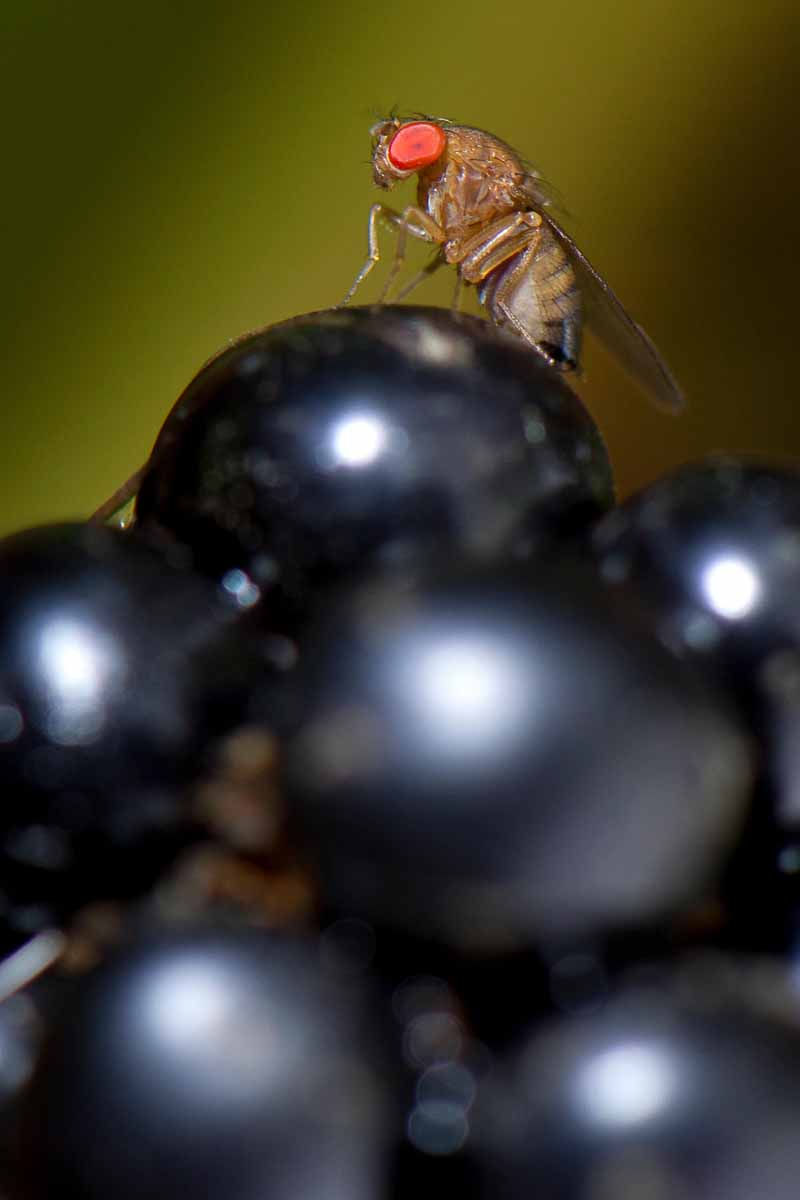
Fruit flies lay their eggs using a long tube called an ovipositor. If you look under a magnifying glass, you can see that the ovipositor of a SWD has serrations on it – like a little saw. This lets her lay her eggs within the fruit.
Within a day of the eggs being laid, the white legless larvae hatch and start feeding inside the fruit if the temperatures are between 43 and 89 F.

Under conditions favorable to the SWD, the fruit begin to collapse as quickly as two days after the eggs were laid. Fruits like cherries will show visible dents around the larvae.
This feeding makes the fruit vulnerable to additional damage from other insects or from molds.
The larvae live for 5 to 7 days before pupating for 4 to 15 days either inside or outside of the fruit.
The fruit will typically fall to the ground by the time the flies start pupating. They can break apart when handled.
The SWD reproduce rapidly and can produce at least 15 generations a year. It doesn’t help that a single female can lay more than 300 eggs in her lifetime!
Also, the flies can complete their life cycle in as little as 10 days under ideal conditions.
Therefore, their populations build up over the season, which makes them a particular threat to late-season berry crops like blackberries, fall raspberries, late-season blueberries, and day-neutral strawberries.
The infestations start when the fruit start to color and continue through ripening.
Preferred Temperatures and Conditions
The SWD live in warmer climates because the eggs and larvae can’t survive freezing. Twenty-four hours at 28 F degrees will kill three quarters of the adult flies, while temperatures of 91 F will have the same effect.
In ideal temperate climates, the SWD live year-round. This includes California, Florida, Oregon, and Georgia.
In regions with cold winters, the flies typically become active in mid-June to early July.
The SWD are most active at dawn and dusk when the temperatures range between 59 and 70 F. Their preferred temperature is 68 F.
Unfortunately, these are the temperatures in the early summer and fall in much of the country at the same time that the berries and other kinds of fruit ripen.
This makes them a particular threat because the flies can migrate between different types of fruit as they ripen at different times, so many kinds of fruit can be infested during a single season.
Because the flies are so tiny, they dry out easily and prefer humid weather. This results in behavior that makes them even more of a threat.
On hot days, they will migrate to the cool, moist canopies inside the fruit trees. This puts them in even greater proximity to fruit that they can infest.
Host Range
The SWD can infest many types of commonly grown fruit, including:
- Raspberries
- Elderberries
- Blackberries
- Strawberries
- Cherries (both sweet and tart)
- Blueberries
- Plums
- Peaches
- Nectarines
- Apples
- Pears
- Persimmons
Grapes are not a preferred host, but the SWD will infest them if they have damage from hail or birds or cracks in the fruit.
These flies can also live on a tremendous number of wild fruit hosts, including berries, American pokeweed, bush honeysuckle, dogwood, and buckthorn.
You can find an extensive list of the wild hosts of the SWD in southern New England at the website of the Cornell University Fruit Resources page for the insect. Chris Maier of the Connecticut Agricultural Experiment Station compiled this list.
Crop Losses Due to the Spotted Wing Drosophila
The combination of its broad host range on fruit, quick generation time, and the way it damages the fruit makes the spotted wing drosophila a highly serious pest.
The SWD can cost growers a fortune and totally destroy late-season crops like blueberries or fall raspberries.
In the western US alone, crop losses due to this pest have been estimated to reach as much as $500 million a year.
The fact that the larvae live inside the fruit protects them from insecticides and makes it even more difficult to control them.
The SWD is difficult to control under any conditions, and even more so for organic growers. However, it is not impossible.
Several major universities had long focused on organic control methods for the SWD.
The USDA National Institute of Food and Agriculture Organic Research and Extension Initiative (OREI) complemented their efforts by funding a two-year study involving multiple universities to learn how best to control this pest and published its results in 2017.
The results are summarized by Dr. Andrew J. Petran.
Detecting With Traps
While the growers of many crops use traps as an indicator of the degree of infestation, the best use of traps for the SWD is to let you know when they first reach your property, so you know to take immediate action.
Another advantage of using a trap in this manner is that you can wait to treat your crops until you are sure you have the SWD on your property.
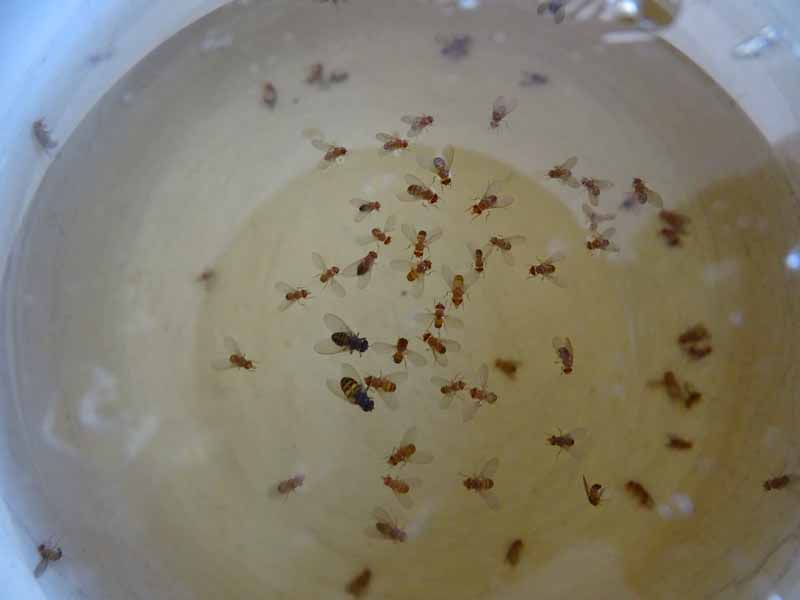
You should monitor from the early stages of the fruit development until the harvest has ended.
However, there are an immense variety of traps in use ranging from homemade sugar or vinegar traps to ones that you can purchase.
The most commonly used one is a clear deli trap with holes in the side and liquid at the bottom that traps the flies.
A 2018 article by Dr. John P Roche in Entomology Today reviewed the doctoral research of Dr. Danielle Kirkpatrick at Michigan State University on choosing the best kind of trap for catching SWD.
Previous research had suggested that red traps worked better. This makes sense, since the flies are attracted to red fruit like cherries and raspberries.
Dr. Kirkpatrick found the flies were much more strongly attracted to red sphere and red panel traps baited with Scentry lure (a specialized attractant for fruit flies).
You can buy red Scentry delta traps from Arbico Organics.
Put a trap in the canopy in the shade or on the north side of the row. If your plants are near woods or riverbanks, put another trap at the closest border to this area.
Usually edges will be more infested than the interiors. If you have multiple traps, you may be able to focus your management on more heavily infested areas.
Commercial lures typically last at least four weeks.
Make sure that the holes in the trap are not blocked with vegetation, so that the SWD can easily fly in.
You should check the traps once a week. You may have a mix of different types of fruit flies, and some native fruit flies superficially look like the SWD.
Use a 10-30X magnifying glass to look for the serrated ovipositor of the SWD females. You can tell the males by the distinctive dark dots on their wings.
Control
If you identify the dreaded pest on your property, it is time to take action. You should do so immediately because the populations can build up very quickly.
For example, the detection of one fly in a conventional berry or cherry grove in Michigan can send the growers into immediate action if their fruit are ripening or are ripe.
Sanitation
Sanitation is extremely important to keep the infestation from spreading. One of the first things you should do is check your fruit.
You can gently squeeze fruit like blueberries. If they are infested, juice will ooze out.
Raspberries are too fragile for this treatment, but infested fruit may leave a red juice stain on the berry receptacle when you have picked the fruit.
Flattened fruit with small bruises or indents may be damaged.
Cull the fruit that are infected and remove them ASAP. You can take several steps to kill the larvae. You can freeze the fruit, or you can bake it by putting it in clear plastic bags in the sun for at least 48 hours.
Or you can dispose of it off-site. It is critical to remove the fruit with larvae, so they won’t emerge as adults and lay eggs!
In the past, experts recommended burying the fruit. However, it turns out that the larvae can escape from the ground, so you should not practice this technique anymore.
If you have help harvesting your fruit, you can give your helpers two buckets. One is for marketable fruit. The other is for damaged or overripe fruit to get as many larvae out of your garden or orchard as possible.
Organic Insecticides
Immediately spray an insecticide unless the plants are blooming. You don’t want to kill the pollinators.
While there would seem to be a number of options of organic insecticides that you could use, research has shown that many of them are ineffective against the SWD.
Researchers at Cornell University, including Laura McDermott and colleagues, tested a number of insecticides that homeowners can buy that are labeled for use against these pernicious flies.
BONIDE® Captain Jack’s Deadbug Brew™ (Spinosad)
Spinosad was by far the most effective and controlled the SWD on cherries, apricots, plums, peaches, nectarines, and blueberries. It was also effective for raspberries, blackberries, and loganberries.
A number of brands that contained spinosad as the active ingredient were highly effective, including formulations of Bonide Captain Jack’s Deadbug Brew that are available via Arbico Organics.
Spinosad for Commercial Growers
However, if you sell your berries, you are prohibited from using the Bonide Captain Jack formulations of spinosad. You will need to purchase Entrust®instead.
Due to concerns about the development of resistance to insecticides, you will have to switch to a different type of organic insecticide after two applications. Most of them do not control the SWD as effectively as spinosad.
Raspberry, blackberry, and blueberry growers are limited to six applications per year, while strawberry growers can make five applications. Stone fruit growers are limited to three per year.
Heather Leach, Matthew J. Grieshop, and Rufus Isaacs of Michigan State University reported that the insecticide Grandevo® has worked well to control the SWD when rotated with Entrust®. Growers have observed some variability in the degree of control with this pesticide throughout the country.
Supplementing Insecticides with Sanitiziers
Two sanitizers used in tank mixes or rotations with insecticides show promise for use in organic programs. Although they are registered as fungicides and not insecticides, Jet-Ag®and OxiDate®2.0 can improve the action of insecticides that are only rated as providing a “fair” level of control of the SWD.

Ortho Bug B Gon Systemic Insect Killer Concentrate via Amazon
Acetamiprid provided good control against the SWD on apple, pear, grapes, or strawberries. This compound is available in a number of formulations made by Ortho, including Ortho Bug B Gon Systemic Insect Killer Concentrate.
One thing that could increase the efficacy of the sprays is to add a small amount of cane sugar to the spray tank. Add 2 teaspoons per gallon of water.
You should spray early in the morning or late in the evening because that’s when the SWD are the most active. If you do this, your treatments will be more successful.
Manage Canopy and Water Usage
Since the flies like cool and moist places, they are drawn to the inside of canopies.
Prune your plants so that the canopy is open with increased sunlight and reduced humidity. This will have the added benefit of improving the spray coverage. This strategy is especially important for organic fruit production.
Also cut back on moisture as much as you can. Fix any broken irrigation lines and wait until the ground and mulch is dry before irrigating.
Cool the Berries Immediately After Harvest
Immediately place your fruit at 34 to 36 F. This will slow or stop any larvae or eggs in the fruit from developing. If you cool the fruit for three days, it will kill the SWD.
If you have customers who pick their own berries, you should encourage them to do this at home. Nothing works like a sticker that says, “Put me in the refrigerator.”
Use Netting
If your plantings are small enough, you can encase them in nettings designed to exclude insects. Use netting with 0.03-inch mesh (1 millimeter).
The USDA OREI research team found that the use of netting “can be consistently effective” at reducing the infestation of the SWD in small fruits like raspberries, blackberries, and blueberries.
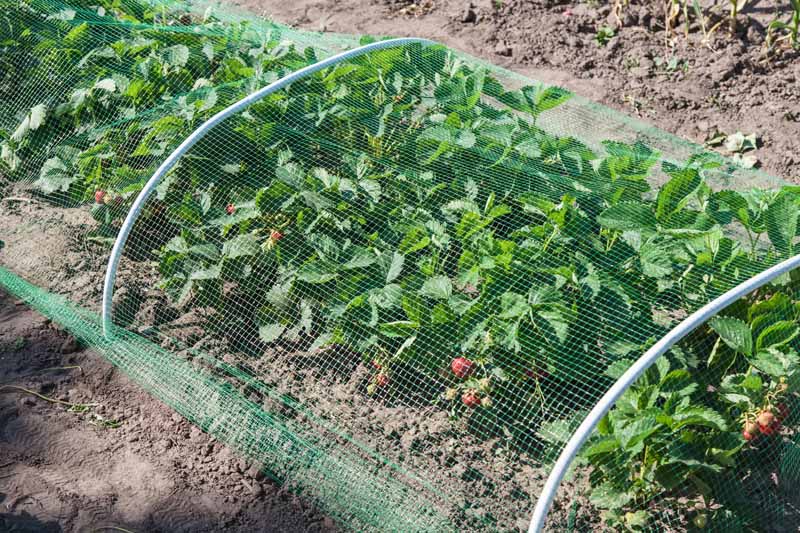
The researchers also found that netting with a heavier mesh (80-gram insect netting) was the most effective at excluding the SWD from the crops.
In addition, Heather Leach, Matthew J. Grieshop, and Rufus Isaacs of Michigan State University found that the combination of netting with organic insecticides reduced the SWD populations more effectively than using either strategy alone.
You can either encase the whole plant in the netting or construct a high tunnel and put netting over the ventilation holes, entrances, and exits.
One concern about this approach is that it can exclude pollinators, so if you have summer-blooming raspberries within netting, you should stock bumblebees or other pollinators to make sure that your plants will get pollinated.
It is critical that you install the netting before the SWD become active. If you don’t, you could possibly end up with even worse infestations than if you did not use the netting.
If you use high tunnels in a warm climate, you may need to use ventilation to prevent your plants from being damaged by overheating.
An additional advantage of using netting is that it can also protect against birds, some other types of insects, and certain rodents.
Mulch with Plastic
Sometimes the larvae drop to the ground and pupate in the soil. By mulching with a black plastic weed barrier, you can interrupt this cycle. Reducing the survival of the SWD can lower the chances that your fruit will become infested.
An added benefit from the plastic barrier is that it helps to manage weeds and retain water.
Harvest Your Fruit Frequently
Ripe fruit serve as strong attractants for SWD. If you wait three days to harvest your fruit, they are likely to build up populations of the pest.
Harvesting every two days or even every day (especially with raspberries) with help to minimize the levels of infestation in your plants.
Regularly Monitor Your Fruit
You should check for infestation between sprays to determine if the treatments are working. It is possible that you could have the larvae in your fruit before you detected any adults in the traps, so it is critical to monitor the fruit.
One way to do so is to randomly select 25 fruit from your garden and put them in a Ziploc bag. Make a solution of saltwater using 1 to 2 teaspoons of salt per cup of water and put it in the bag.
Lightly squeeze each fruit, and put it in the solution for 15 to 30 minutes. Then see if any larvae are floating in the water
You may need to use a magnifying glass if the larvae are small. The easiest way to see them is to put a light behind the bag that will shine onto the larvae.
If not, you know that your fruit are not infested! If you do find larvae, it’s possible that they are from some other kind of insect.
Another way you can check your fruit is to look for the “stings” – the tiny holes that the females created when they laid their eggs in the fruit.
Phenology Management to Avoid the Spotted Wing Drosophila
If you know what time of year the SWD are typically active in your area, you can plant early season crops, so that the fruit will have already ripened by the time the flies materialize.
This approach is known as Phenology Management.
Your local extension agency can provide charts showing when the pest is normally active in your area.
An example is a blueberry grower in southern Minnesota. If he or she plants an early maturing variety, such as Bluecrop, Draper, or Duke, the fruit will mature in early July – before the SWD starts attacking crops in the area.
Some growers avoid fall raspberries entirely and only focus on a summer crop. Short-day strawberries that bear in June are less likely to be affected by SWD than are day neutral strawberries that mature later in the season.
Another option is to select varieties of fruit that have thicker skins, since the flies take longer to lay eggs in these types of fruit.
Organic Techniques Can Triumph Over the Spotted Wing Drosophila
The spotted wing Drosophila is highly aggressive, prolific, invasive, and can completely destroy late berry crops.
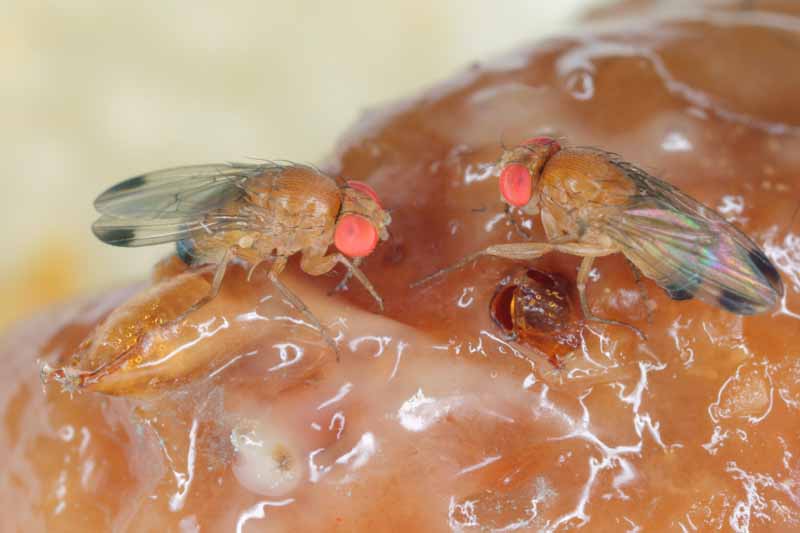
However, by using an integrated pest management (IPM) approach, you can control this pest using organic techniques.
Monitoring for the fruit flies is a key part of any control program, since you must leap into action immediately after discovering a spotted wing Drosophila on your property.
With great care, you can avoid being one of the growers who loses their late season crop to the ravages of this pest.
Other Resources:
© Ask the Experts, LLC. ALL RIGHTS RESERVED. See our TOS for more details. Product photo via Scenrty®, BONIDE®, and Ortho®. Uncredited photos: Shutterstock.
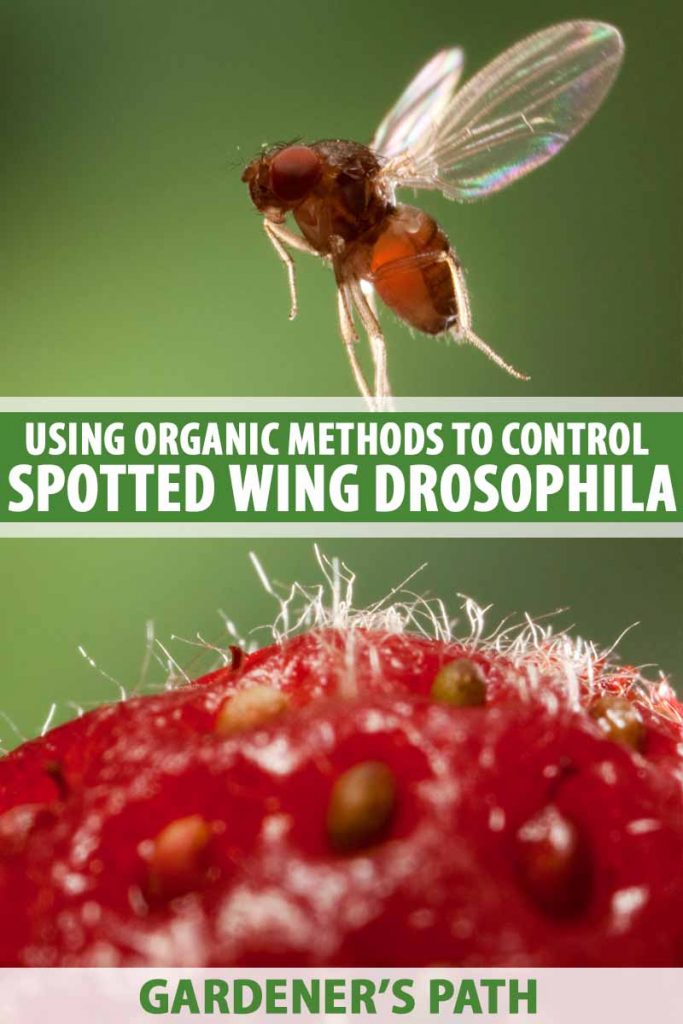
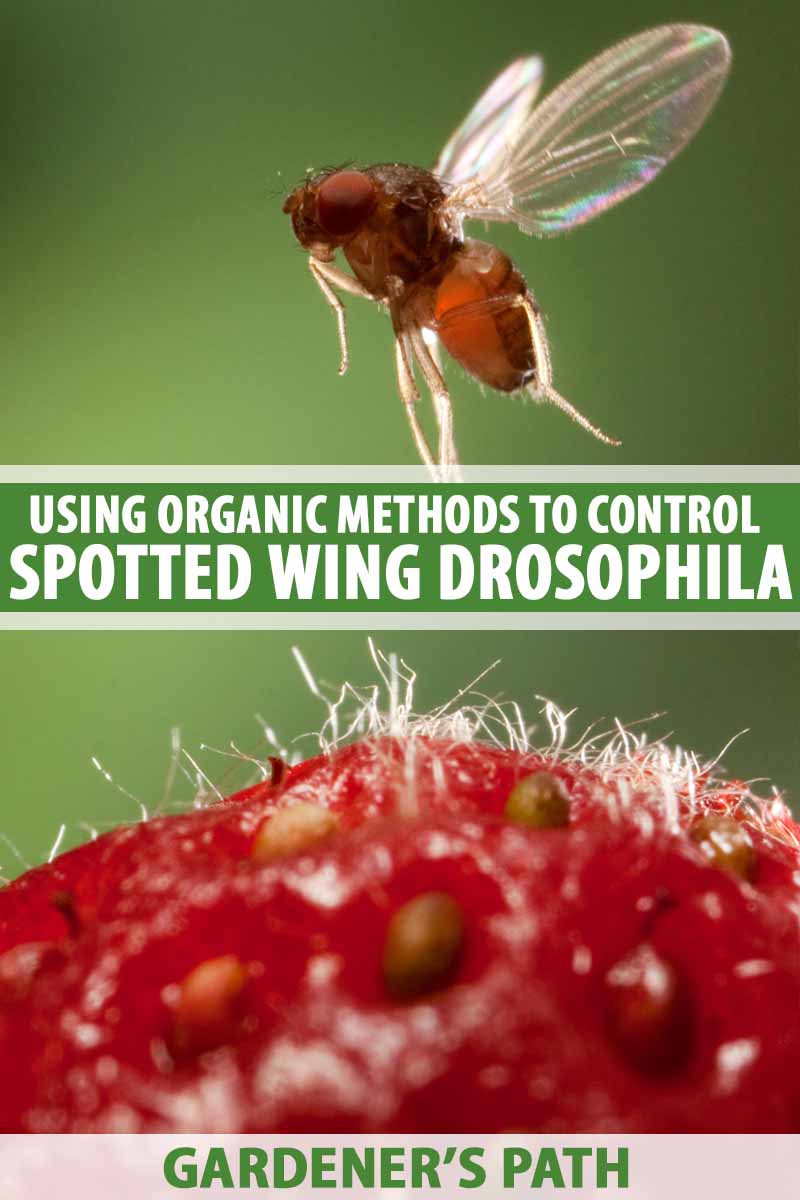
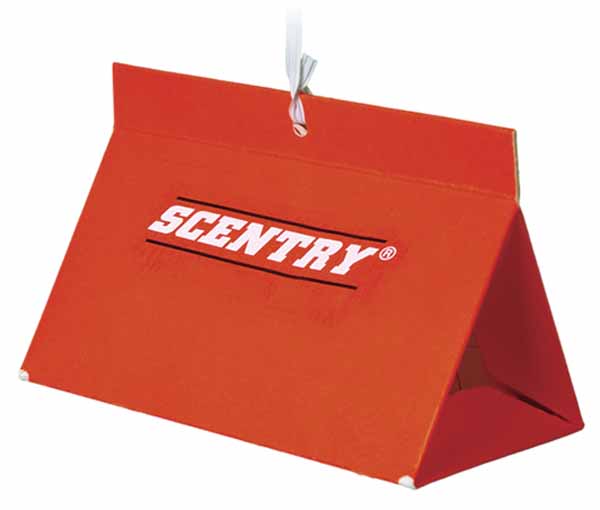
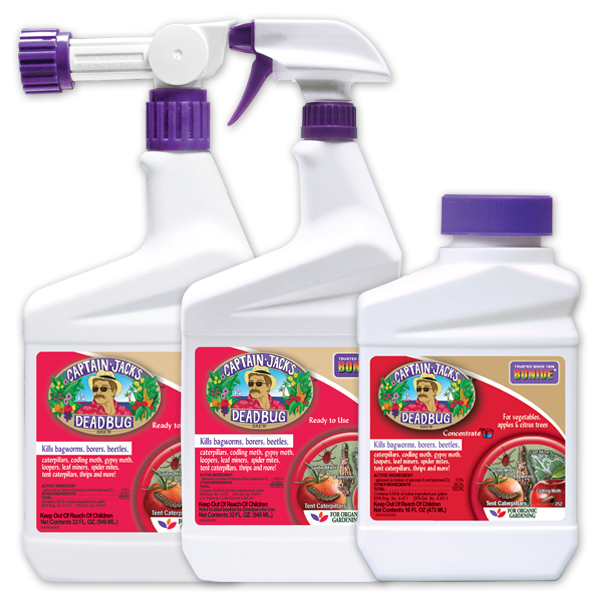
Great article. I look forward to applying these methods in our blueberry patch in NW Washington.
Thank you so much! That’s very kind of you to say. I hope the techniques work well for you. It seems like such a horrific pest.
What about Pyrethrin based sprays? I’ve seen at least one that also includes Neem Oil, but not Spinosad, so I’m wondering if I can alternate between these 2? I definitely have the SWD, and have had blackberry crops (home garden) decimated by them, to the point that I gave up mid-season. This year I’m picking early/daily, but hard to reach areas have given the SWD a foothold.
Hi Bob, I’m sorry to hear that you have the SWD in your blackberries – what a horrific pest. Yes, you can definitely alternate between the two. Spinosad is highly recommended. Pyrethrins are more toxic towards bees and beneficial organisms, but the University of Missouri recommends Pyganic for homeowners to use to control the SWD. Their PDF on the SWD has really clear recommendations for insecticides to use to treat SWD infestations. You can find it here. However, Colorado State University recommends against pyrethrins, because of their short residual activity, and say that they have not been effective against the… Read more »
Thank you so much for this current and applicable information. Last year, I found I had huge infestations of SWD in my home blueberries and raspberries. I also now realize why my fields of wild black raspberries and blackberries had not produced (gone before I got to them), for years. I was interested in the temperature tolerance you mentioned. Here in NYS, would the larvae die in the ground over the winter? If they do, does the SWD fly in from warmer areas to re-infest? I also can not find any information about soil drenches to kill the larvae in… Read more »
Hi Bonnie, I’m so sorry that your berries are infested with SWD. Your questions are all excellent ones. 1) Everything I have read suggests that the larvae would not survive freezing in NYS. They do better in more moderate climates. It’s unclear how the insect survives the winters in the Northeast. 2) It appears that soil drenching is not recommended as a means of control. My guess is that it’s not feasible to treat such large areas of soil. 3) Great idea with the black plastic. I’m not sure if it would keep the larvae from emerging, but there is… Read more »
FYI, I have had great home garden success with biocontrol of SWD using a beneficial nematode which is recognized as effective for drosophila control – Steinernema feltiae. After seeing my ripe raspberries filled with little white maggots 2016, I found that soil drench applications of the nematodes in 2017 and 2018 resulted in clean, raspberries (red and purple) by 2019 and through the 2022 season And the benefit extended to neighboring plantings of figs and blueberries. The theory here is that the nematodes cut the SWD reproductive cycle by parasitizing SWD larvae and pupae in the soil. It has worked… Read more »
Thanks for sharing- this is great news, Patrick! I’ve seen reports of testing the effectiveness of Steinernema riobrave against SWD as well. Readers who are interested in learning more about beneficial nematodes can read our guide.
Thank you, Allison, for the link to Helga’s excellent guide on beneficial nematodes. I think that is one of the best discussions for home gardeners that I have seen on Steinernema and all its little beneficial relatives. As noted there, S feltiae is a “cruiser” predator, but a mix adding a “waiter” such as S Riobrave would probably also contribute to SWD control. The key to achieving SWD biocontrol success is to ramp up the predator population as fast as possible. You can buy hundreds of millions of nematodes from the labs, but you will need millions more to get… Read more »
Thanks again, Patrick!